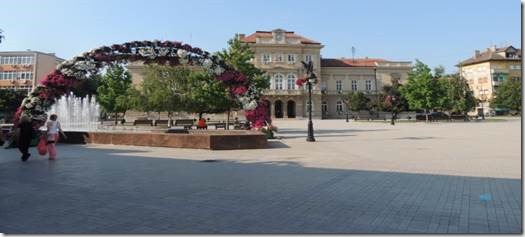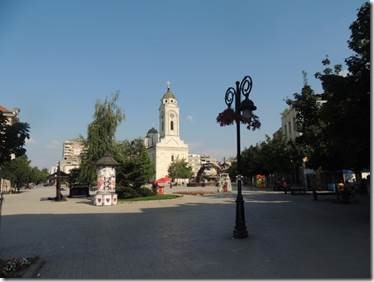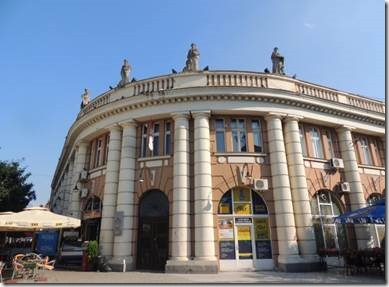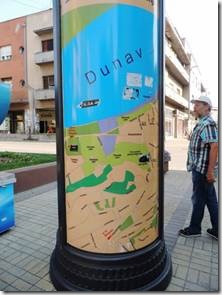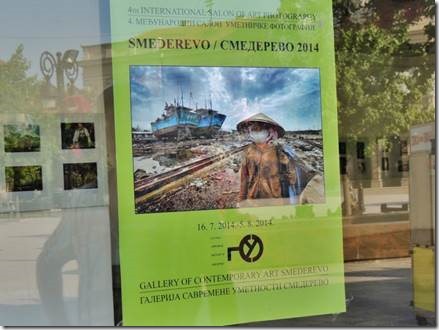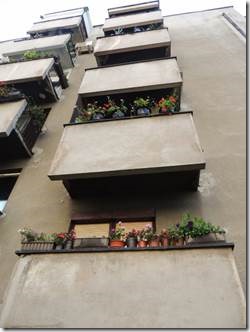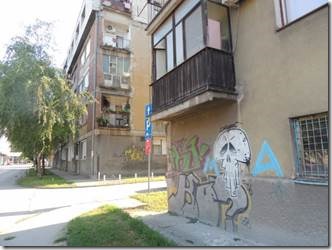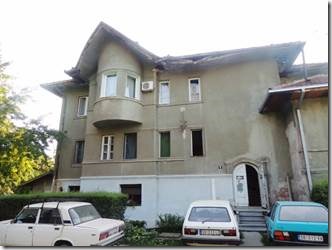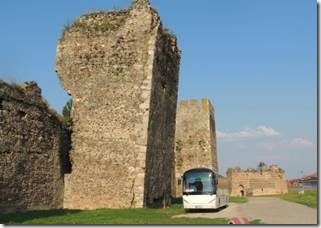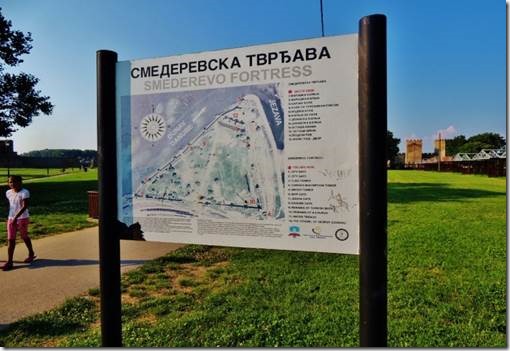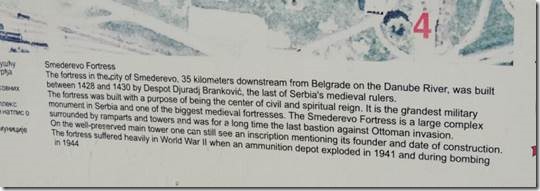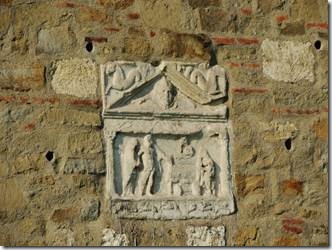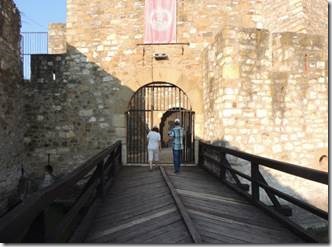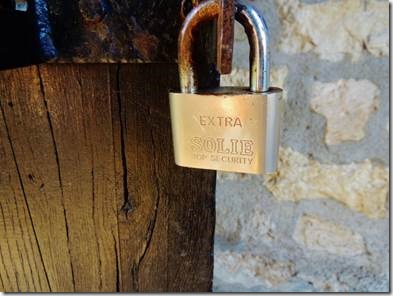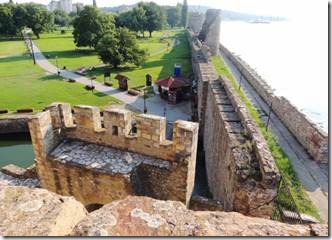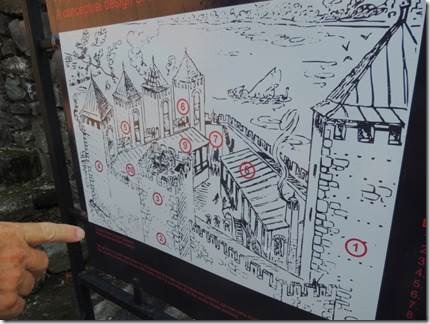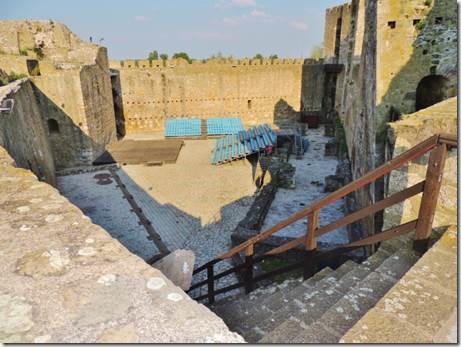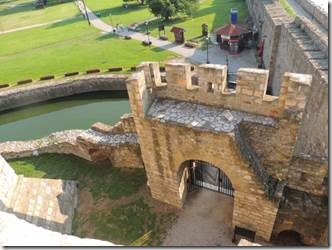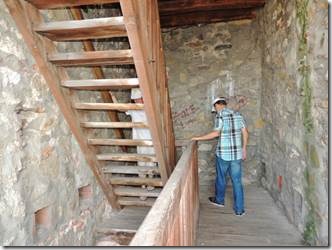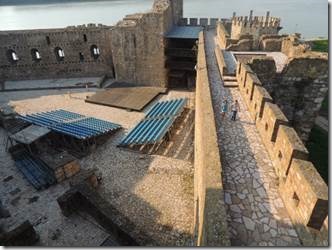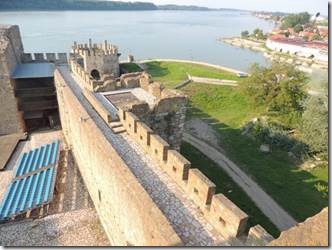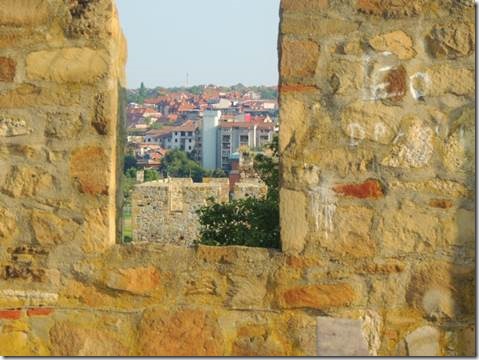Hotel Drustar dock with wifi
Silistra, Bulgaria
This is my last email of the evening. We left Belgrade and stopped at Smederevo. Here’s the story. The city center is charming; the Fortress fun, the newer parts of the city hopeful, but the older parts show that the economy of Serbia is still struggling.
Ru
Smederevo http://www.smederevowelcome.com/index.html
We arrived in Smederevo just about noon time and tied up at the one restaurant barge that could accommodate our size. Rick and Mary had stayed there previous trip along the Danube. But no one was about. Thinking the restaurant next along the Danube might have some knowledge of our restaurant as well as a lunch menu we walked there. No info and no food, just drinks. So we tried the next place. No info, no food. We were pointed along to the final restaurant. They had no info but they did have food. We killed a few hours between finding some food and eating it. It was a hot day, as most of them now are. Really too bad this trip can’t be done in the fall when the weather is cooler, but the Danube and Black Sea freeze, and though we’ve been called an “ice breaker,” we’re not. When we returned we noticed a man in the restaurant, the same person Rick and Mary had dealt with previously. We could tie up, have no water or power for 30 Euro. That was really too much compared to everyplace else we’d stopped. Randal told him 20 and that was fine. He warned us there would be a private party lasting until the early hours of the morning. But there was no other choice. Too loud and too awful but the river seems to attract disco restaurant barges. This was a problem in the Philippines, Malaysia, Israel and Marmaris too. Thankfully in Marmaris we have AC so we can close up the boat and muffle the noise somewhat. Along the rivers we’re not using the AC so need to keep hatches and portholes open for the cool air. We only stayed the one night though the town deserves more if you ever go.
Leaving Belgrade, the first town of significance reached by heading east along the Danube is Smederevo, a port and industrial town of about 117,000 inhabitants. http://www.smederevowelcome.com/
|
Republic Square “Republic Square represents the central part of the contemporary town fabric of Smederevo. With its historical continuity, triangular urban form and representative heritage, it shows the identity of the town itself and together with the Fortress expresses its recognizable profile. It was established in the first half of the 19th century, after the Second Serbian uprising, on the place where the Big Market connected the Serbian and Turkish part of the town. During the time of Knez Miloš, in 1837, was made the Plan of Development, with which the shaping of this space as a central town square began. With the building of the church of St. George in 1854 was the basics of the further development defined. With this religious building, the dome, around which the whole town gravitates, was also the center of Smederevo itself definitely founded. New buildings were raised: in 1888 the Prefecture and in 1926 the City Court, which with their architectural and stylistic expression tell of the creation of an ambience of a European town center. Thereby was the shape of the square finally regulated. The homogenization and shaping of the spatial structure contributed, in the time between the world wars, to the building of several objects in different styles and with different functions: The Ninić hotel building (today the Town Gallery), and immediately next to it, a business-apartment building that has been shaped to fit in, the building of the former pharmacy Pantazijević which solved the problem of the corner at the entrance to the Square; the building of the former library (today Historical Archives). During the Second World War, the most valuable objects on the square were badly damaged and renovated more recently. After the war, new urbanistic projects as a rule did not respect the peculiarities of the ambience, so that in certain segments the spatial unity destroyed, especially by new building. With the beginning of the new century, a more positive way of handling this space came about. Reconstruction and ground-floor arrangements were done with the aim of making both the functional and the aesthetic values of the square more contemporary and making them stand up. Dominated by the Temple of the Holy Great Martyr George the Victorious and there are a monument to fallen soldiers in World War I, County Administration Building, the Gallery of Modern Art and the famous fountain, a meeting place, rest and entertainment among city’s youth and senior citizens.” http://www.smederevowelcome.com/republic-square.html Church of St. George |
|
The Old City Hall and a city map: notice the river here is called the Dunav “The building of the former city hall was raised between 1926 and 1928, as a project of the Russian architect Nikolaj Krasnov in the spirit of eclecticism. The edifice is built in an angle – it is in the shape of the Cyrillic letter “g” (Г). The facade is vertically divided, dominated by 22 massive pilasters horizontally adjoined, between which there are large, arched openings at the ground-floor, and at the first floor along the right-angled openings. A characteristic of the building are four richly draped sculptures personifying justice, work, science and culture, which are placed on the balustrade above the roof wreath.” http://www.smederevowelcome.com/the-building-of-the-old-city-hall.html |
|
The Gallery of Modern Art has been operating as a part of the Museum in Smederevo since 2005. It is located on the main town square, the Republic Square, and has a representative exhibition area. Expert services of the Gallery, with the help of the gallery Art Council, create programs every year filled with rich and varied exhibitions in the field of contemporary art. The art framework of the current program of the Gallery of Modern Art in Smederevo, which tends to develop in the future, covers a wide range of different forms of contemporary artistic expression, from (post)conceptual approach and radical language attitudes, through traditional mediums of paintings and sculpture, which are experimented upon, to classical forms of artistic expressions of a higher quality (mosaic, collage, photography, drawing…). http://www.smederevowelcome.com/gallery-of-modern-art.html It was open in the morning and evening but we were there in the afternoon. |
|
Some older neighborhoods between Republic Square and the Fortress |
|
Smederevo history and the Fortress: “Smederevo began life as a Roman settlement on the route from Singidunum to Viminacium. In 1427, it became the new Serbian capital, when the Hungarians took over Belgrade again following the death of Stefan Lazarević. The castle is triangular in shape, with five gates, 25 large towers, double ramparts and a moat. At one end of the complex is a smaller stronghold that consists of a place and a citadel, which has its own moat and four bastions. On one of the bastions is the date of the building, 6938, the numbers of years reckoned by the Orthodox Church to have elapsed since the world was first created, which corresponds to the date 1430 in the Roman calendar. Considering that the castle was erected very quickly, within a year from 1429-30, its dimensions are hugely impressive: the walls of the keep at the north of the inner fortress are about 5m thick, and the total distance around the perimeter is about 1.5km. The castle’s construction was by order of Đurađ Branković, son of Vuk, who was despot at the time. The notion was to provide an impenetrable barrier to the Turkish advance that was taking place during this period. One legend states that the impoverished peasants who built the castle were obliged to provide thousands of eggs to mix with the mortar in order to firmly secure the stones, while another asserts that it was Branković’s tyrannical Greek wife, Jerina (known by her subjects as ‘Damned Jerina’ and said to bathe only in milk), who gave the order for the castle’s construction. Either way, it is undeniable that a great deal of forced labour had to be recruited to build such an extensive and imposing structure in such a short time. The Turks eventually arrived to subdue the fortress but it took them more than 20 years to do so. Smederevo Fortress was finally surrendered in 1459 to Sultan Mehmet I, which marked the final victory of the Ottoman Turks over Serbian territory. Immediately, the Turks made the castle the headquarters of their pašalik in the region and it remained in Turkish occupation, with the exception of a brief period of Austrian control, until 1805 when Karađorđe formally received its keys following his initial success with the First National Uprising. Having survived the medieval period more or less intact, the fortress suffered considerable damage in far more recent times when a German ammunition depot blew up part of it in 1941 claiming more than 5,000 lives, and then later in 1944 when it was bombed by Allied forces.“ http://www.smederevowelcome.com/history.html |
|
For Peter and Jane, the lock on the castle gate |
|
Once upon a time A moat with water Looking down river to the new port facilities Old and new |

